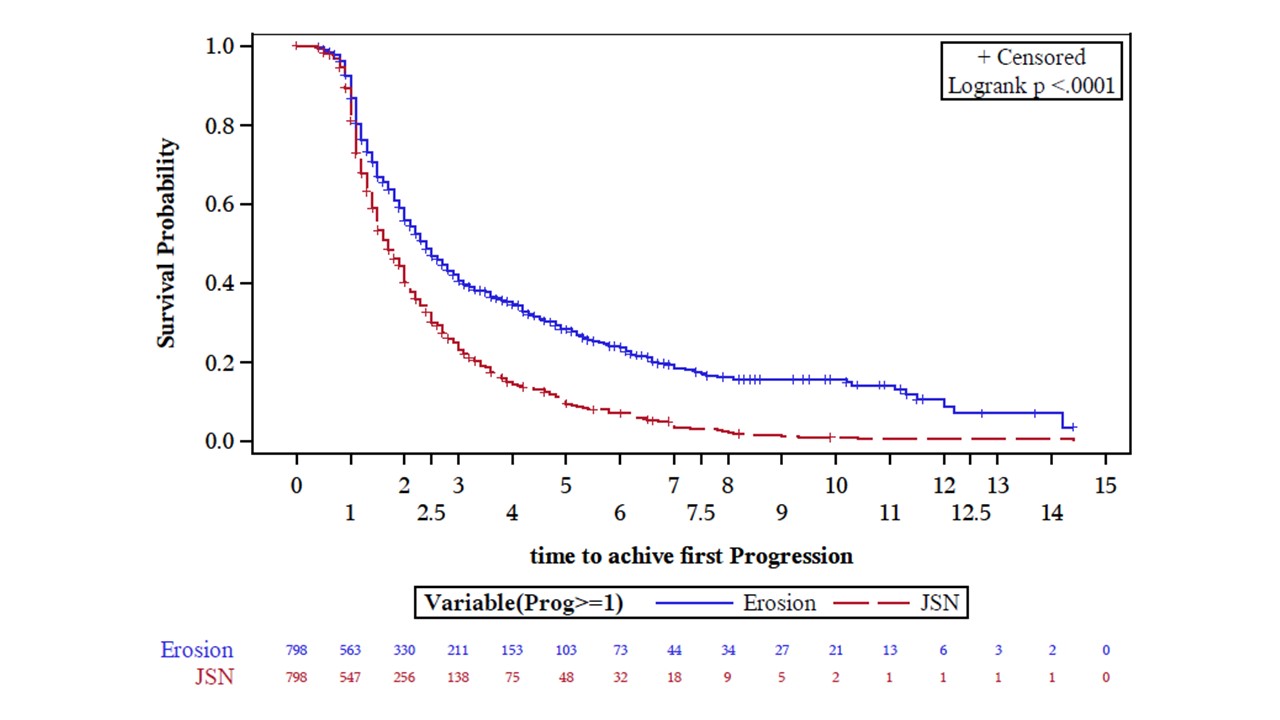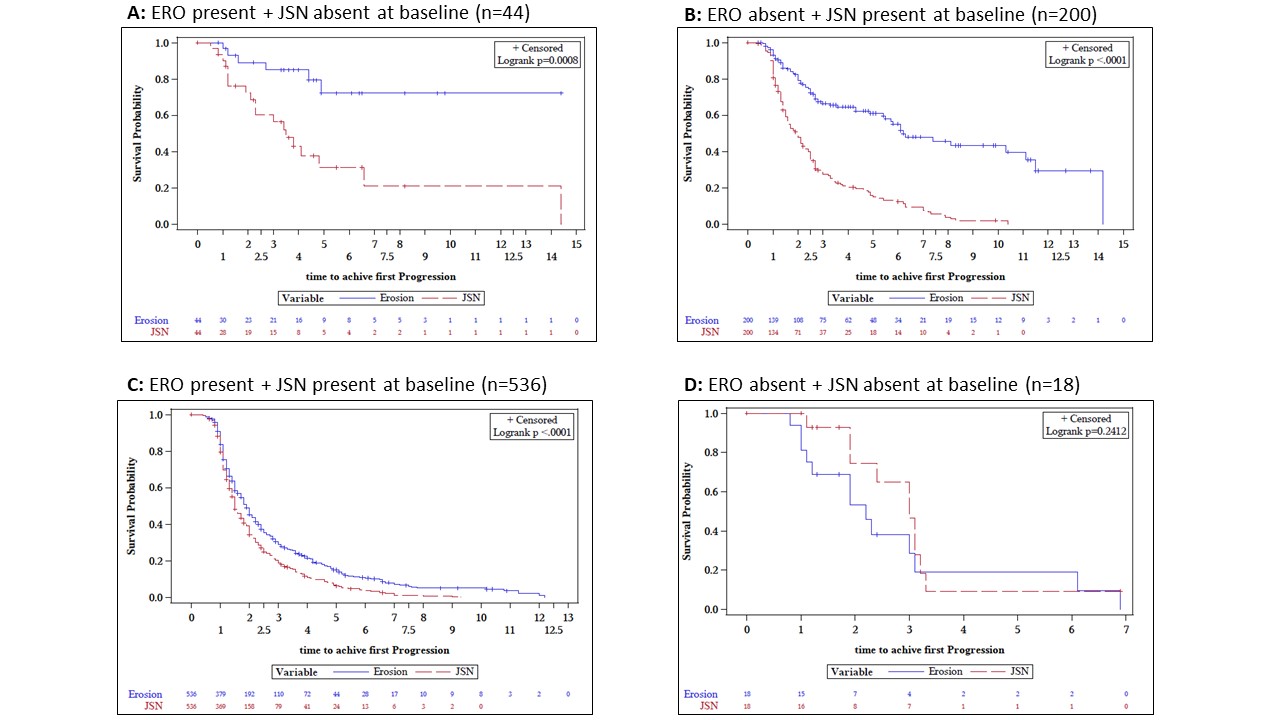Session Information
Date: Saturday, November 7, 2020
Title: RA – Diagnosis, Manifestations, & Outcomes Poster II: Biomarkers
Session Type: Poster Session B
Session Time: 9:00AM-11:00AM
Background/Purpose: Rheumatoid arthritis (RA) is a chronic inflammatory disease characterized through symmetric polyarthritis leading to joint destruction over time in many patients. Radiographic damage is an important outcome in RA clinical trials, most commonly assessed by conventional radiographs and quantified/reported by the modified total Sharp van der Heijde Score (mTSS). The mTSS is assessing erosive (ERO) changes as well as joint space narrowing (JSN; reflecting cartilage wasting) in the small joints of the hands and feet. While erosions are the hallmarks of RA, loss of cartilage has been reported to be highly relevant for functional limitations in RA. The sequence of occurrence of these events is not completely understood.
Methods: Radiographs of RA patients from a large prospective clinical routine cohort were scored using the mTSS by one experienced reader (G.S.) unaware of the aim of this project. Time-to-JSN and time-to-ERO was estimated using survival analyses utilizing the Kaplan-Meier estimator. In additional analyses, patients were stratified based on JSN and/or ERO damage at baseline. Further, potential predictors (demographics, csDMARD/bDMARD treatment/combination therapy) of time-to-ERO and time-to-JSN were evaluated using Cox-regression techniques. All statistical analyses were conducted using SAS v9.4 (Cary, New York, USA).
Results: We assessed 798 patients longitudinally for radiographic progression. JSN occurred significantly earlier than erosions (p< 0.001, Figure 1). After stratification for baseline damage (Figure 2), these differences remained significant with a shorter time-to-JSN in patients without any baseline ERO or JSN (n=44, p=0.008), patients with JSN but no ERO at baseline (n=200, p< 0.001), and patients with baseline ERO and JSN (n=536, p< 0.001). Only in the small group of patients with isolated erosions (without JSN) at baseline there was no difference in time-to-progression of ERO vs. JSN (n=18, p=0.241). Overall, shorter time to progression of ERO was significantly predicted by positivity for rheumatoid factor or anti-citrullinated peptide antibodies (CCP; p< 0.003), as well as by erosions at baseline (p< 0.001) in Cox regression. In contrast, seropositivity for neither RF nor CCP was associated with shorter time to JSN progression (p=0.226); however, baseline concomitant JSN and ERO damage did show to be a significant predictor (p< 0.001).
Conclusion: We identified a significantly shorter time to progression of JSN compared to ERO in this longitudinal cohort of RA patients. JSN remains an important radiographic outcome, as it is strongly associated with impairment of physical function. This calls for a stronger focus on cartilage damage in RA, and a stronger consideration of JSN in routine evaluation of RA radiographs in clinical practice.
 Figure 1: Kaplan-Meier analysis showing time to progression of radiographic progression. Curves represent time to first occurance of joint space narrowing (red) and erosive (blue) progression.
Figure 1: Kaplan-Meier analysis showing time to progression of radiographic progression. Curves represent time to first occurance of joint space narrowing (red) and erosive (blue) progression.
 Figure 2: Time to progression of structural damage after stratification for baseline damage. A: Patients with erosions and absence of joint space narrowing; B: Patients with absence of erosions and presence of joint space narrowing; C: patients with presence of erosions and joint space narrowing; D: patients with erosions and absence of joint space narrowing.
Figure 2: Time to progression of structural damage after stratification for baseline damage. A: Patients with erosions and absence of joint space narrowing; B: Patients with absence of erosions and presence of joint space narrowing; C: patients with presence of erosions and joint space narrowing; D: patients with erosions and absence of joint space narrowing.
To cite this abstract in AMA style:
Kerschbaumer A, Supp G, Alasti F, Smolen J, Aletaha D. Joint Space Narrowing Precedes Erosive Radiographic Damage in Patients with Rheumatoid Arthritis [abstract]. Arthritis Rheumatol. 2020; 72 (suppl 10). https://acrabstracts.org/abstract/joint-space-narrowing-precedes-erosive-radiographic-damage-in-patients-with-rheumatoid-arthritis/. Accessed .« Back to ACR Convergence 2020
ACR Meeting Abstracts - https://acrabstracts.org/abstract/joint-space-narrowing-precedes-erosive-radiographic-damage-in-patients-with-rheumatoid-arthritis/
